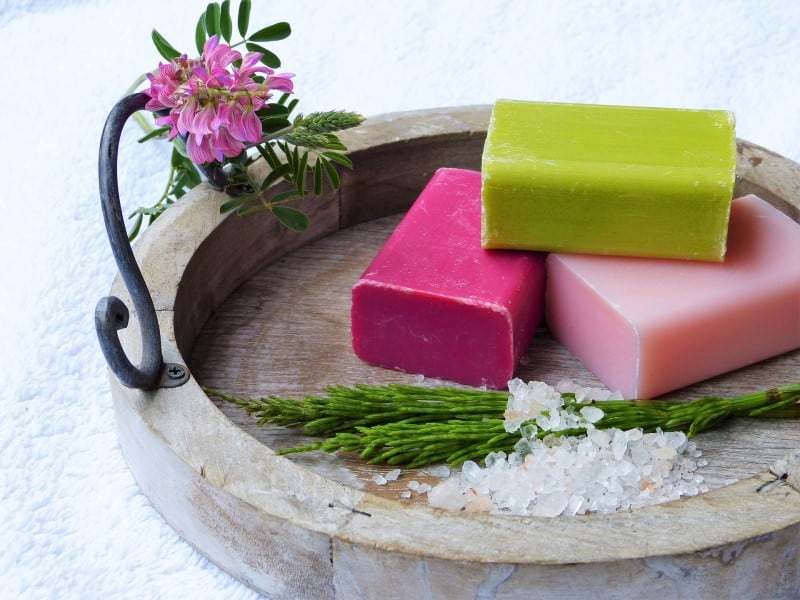Candle and soap making are great hobbies to take up, whether you pursue these hobbies alone or with a friend. It’s also convenient because you can use essential oils in both soap and candles so you can coordinate your fragrances. Many people enjoy adding some more personality to their candles and soaps by adding color too. This can bring up the question of if you can use soap coloring in candles like you can use essential oils interchangeably.
Candles cannot be dyed by soap coloring because the glycerin in soap coloring does not mix well into the oils in wax. To color a candle, you need to have an oil based coloring agent, which excludes soap coloring agents because they tend to be water based.
Making candles is a fun way to spend a day as long as you know what products to use and what to stay away from. In this article I’ll go over the types of coloring agents you should be using for your candle making as well as why you should avoid other coloring agents.

Created Candles with Coloring Agents
When you’re creating a candle, you may want to add some color to add a little more personality or to complement the fragrances you’ve added. When adding color you want to make sure you’re using the right types of products so you’ll be able to have a successful creation instead of ruining your candle.
What Coloring Agents Should You Use?
To successfully color a candle you need to remember what candles are made of. They’re made of wax, which is a compound derived from oils. So when choosing a coloring agent, you want to make sure you choose one that is designed to be used for wax or will work in waxes.
Candle Dye
Candle dyes are synthetic coloring agents that are specifically designed to dye your candle effortlessly. You can find candle dyes in flake, liquid, or block forms. If you’re looking to mix colors or make a vibrant candle that’s highly saturated in color, then liquid candle dyes are the best route for you. If you want a medium or pastel colored candle, then your best option would be to use flake or block candle dyes.
When adding your candle dye to your candle, you want to make sure you’re including it at the right time. If you choose to use a liquid candle dye, you want to make sure you’re adding it into the candle at the same time you add your fragrances in, which should be when the wax is around 185 degrees. Also, make sure you’re not adding too much dye because it may alter the fragrance or burn of your candle. Start with 1 to 2 drops at first and go up from there.
When using a block or flake candle dye, you will want to add these before you melt your wax to ensure that it is all melted and blended evenly. Again, you should start small with around a fourth to a half of a dye block per pound of wax you use. If you think your candle isn’t going to have a rich enough color after that melts down, add more to your melting pot. You just need to be careful and ensure that the dye block or flakes melt completely.
Natural Dyes
If you’re looking for a more natural way to dye your candles, a good route for you is to steep herbs in your melted wax. This is a good natural route because you most likely won’t find a natural coloring agent in stores. This method is best used in soy wax or beeswax instead of paraffin wax because soy and beeswax are more natural.
To infuse the color from herbs into your candle, you will need to choose what color you want. Here are some herbs that can give your candle a beautiful color:
- Lemon Peel: yellow/orange
- Parsley: green
- Paprika: a deep and rich orange
- Orange peel: orange
- Rosemary: green
- Turmeric: Bright yellow
- Kelp: green
- Alkanet root: purple/red
- Madder root: peach
One of the downfalls of using herbs to color your candles, though, is that it’s a very time consuming task. When using herbs, you need to steep them on low heat in the candle wax, which may take hours to color your whole candle. You’ll also be given an pastel color instead of a vibrant, bold color. If you’re looking for a more vibrant color, this is not the best route for you.
What Coloring Agents Should You Avoid?
When dying candles, you want to make sure you’re avoiding coloring agents that aren’t going to color your candle well or at all. In this section, I’ll give you some options that people commonly turn to that don’t give you a successful result.
Food Dye and Soap Dye
I’ve grouped food and soap dye together because they are both unsuccessful for the same reason. These dyes are water based and do not mix in with the oil makeup of wax. This stems back to the science experiment done in schools. When you add water and oil into a bottle and shake it up, you can shake it for as long as you want but at the end, you’ll just be left with beads of oil that will make their way to the top of the bottle.
This happens in with candles too. When you add food coloring or soap coloring into your melted wax, you can stir it as much as you want but all you’re going to end up with are little beads of dye that will eventually sink to the bottom of your candle wax. The more you mix it, the smaller the dye beads get but you won’t have any color being absorbed into the wax.
I think it’s important to note that there is food dye that isn’t water based. You can get oil based food colorings in the form of pastes but these still aren’t recommended for candle dying use. Food dyes are meant to color food and aren’t meant to be exposed to an open flame like it would be with a candle. Because of this, you may be creating a fire hazard by adding food dye into your candles.
Mica Powder
Mica powder has mixed reviews as to whether or not they’re good coloring agents for candles. Yes, they will color your candles, but they won’t always color them evenly or mix into your wax evenly, leaving chunks of mica powder throughout the candle. If you really want to use mica powder, its best use is for a finishing touch. You can use mica powder on the top of your candle to create a shimmery finish for your candle.
If you use mica powder throughout the candle, you’ll be given a shimmery effect throughout the melted wax. You won’t be able to see the shimmer when the wax is cool and hardened but it will be prevalent as the wax melts. If you choose to use this to color your candle, though, keep in mind that it may not mix evenly and won’t be as good of a coloring agent as candle dyes are.
Read more about Is Mica Safe in Candles?
Crayons
Many people have used crayons as a quick replacement instead of having to go to a store to get candle dye. While this may seem like a good idea because crayons are colored wax, candles colored by crayons do not produce a good burn. The wax components in crayons are different from the wax components in candle wax and they’re not meant to be burned using a wick.
If you use crayons to color your candle, you will most likely end up with the color you intended or a color you enjoy, but the integrity of your candle is going to be off. These candles tend not to have as visually pleasing of an appearance as candles colored with candle dye. Also, the crayons prevent the candle from burning evenly, which can lead to tunneling or just an uneven burn pool leading to wasted wax.
Final Thoughts
When coloring a candle, it may seem like a good idea to use soap dye because you can use fragrance agents interchangeably between candles and soap. This isn’t the case, though, as soap dyes tend to be water based, just like most food dyes are, and won’t mix into the wax because it is oil based.
Because of this, you should seek out different candle dying methods such as using dyes specifically made for candles or using natural dyes through herbs. These dying agents are the most effective for your candle making journey.
Read more:
